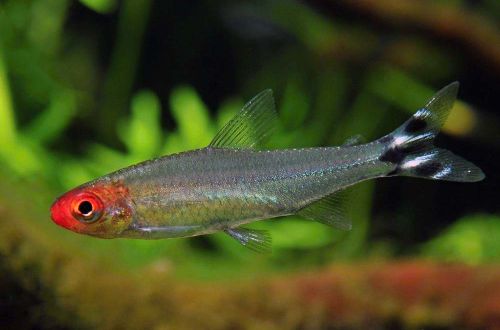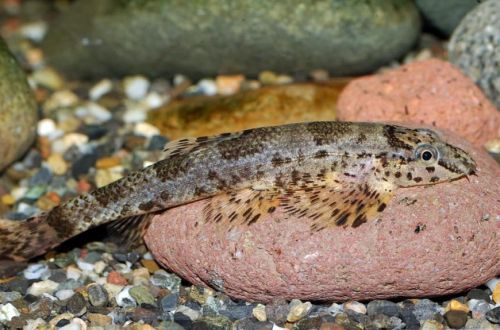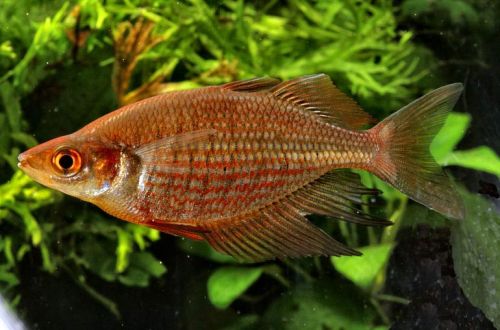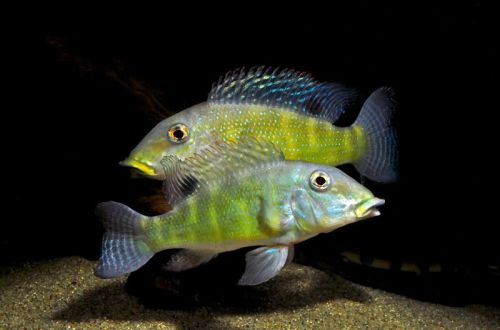
Шингу ретрокулус
Xingu retroculus, scientific name Retroculus xinguensis, belongs to the Cichlidae family. Not the most popular American cichlid, largely due to its nondescript coloration and living conditions (strong currents) that are unsuitable for many other freshwater fish. Recommended for species aquariums or biotopes.

Мундариҷа
Муҳити зист
It originates from South America from the basin of the Xingu River and its left tributary, the Iriri, flowing through the territory of Brazil (the states of Para and Mato Grosso.). There are records that this species of cichlid has also been found in the Tapajos River basin. It occurs in sections of rivers with numerous rapids and fast, sometimes seething, currents. Such regions contain boulders of various sizes, sandy and rocky substrates.
Маълумоти мухтасар:
- Ҳаҷми аквариум - аз 700 литр.
- Ҳарорат - 26-32 ° C
- Арзиши рН - 6.0-8.0
- сахтии об - 1-12 dGH
- Навъи субстрат - хокӣ, санглох
- Равшанӣ - тобеъ
- Оби шӯр - не
- Ҳаракати об - мӯътадил, қавӣ
- Андозаи моҳӣ 15-20 см аст.
- Хӯрок - ҳама гуна хӯрок
- Мизоҷ - шартан осоишта
- Мундариҷа дар гурӯҳи на камтар аз 5-8 нафар
Тавсифи
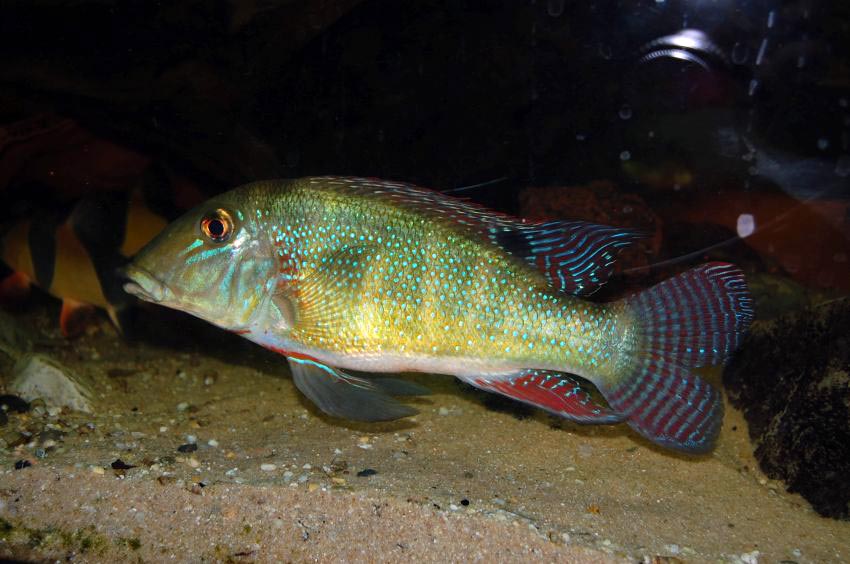
Adult males reach a length of up to 20 cm. Females are smaller – about 15 cm. Males also differ in the shape and color of the ventral and anal fins, they are more pointed and have red pigmentation, while in females they are rounded gray translucent. In fry and young fish, sexual dimorphism is weakly expressed.
Coloring consists of a combination of pale yellow, green and gray shades. Wide dark vertical stripes are noticeable on the body.
таъом
An omnivorous species, they feed mainly in the bottom layer, but they can easily grab food in the water column. The diet may consist of dry food in combination with live or frozen brine shrimp, daphnia, bloodworms, mosquito larvae, as well as small earthworms, etc. On occasion, small fish can be eaten.
It is important that the food contains herbal supplements, such as spirulina flakes. Feed small meals 3-5 times a day.
Нигоҳдорӣ ва нигоҳубин, ташкили аквариум
The optimal size of the aquarium for a group of 5-8 fish starts from 700 liters. The decoration should resemble the natural habitat: boulders of variable size, driftwood, sand and gravel substrate. It is possible to add some unpretentious plants that can grow in conditions of moderate or strong current. Species rooting directly on rocks or woody bases are preferred. In some cases, additional pumps are required to create an internal flow, although efficient filters often cope with this task.
Xingu retroculuses are intolerant of the accumulation of organic waste and require high levels of oxygen dissolved in water. Successful keeping depends on providing stable water conditions without sudden changes in temperature and hydrochemical values. Also, dangerous concentrations of products of the nitrogen cycle (ammonia, nitrites, nitrates) should not be allowed to reach. Achieving ecological balance is achieved by installing the necessary equipment (filters, aerators, heaters, lighting system, etc.) and regular maintenance of the aquarium. The latter include weekly replacement of part of the water with fresh water, removal of organic waste in the form of food and experiment residues, equipment maintenance, etc.
Рафтор ва мутобиқат
Relatively peaceful fish, but can be dangerous to very small species, and is not recommended to be combined with bottom-dwelling fish such as catfish and char. The choice of aquarium neighbors is also limited by the rather turbulent habitat of Retroculus Xingu. In addition, during the spawning period, the male becomes quite aggressive towards those who invade his territory.
It is recommended to maintain a group of at least 5-8 individuals of both sexes. With fewer numbers, dominant alpha males may chase weaker congeners.
Парвариш / зотпарварӣ
Under favorable conditions, fish are able to give offspring with an enviable frequency. With the onset of the mating season, the male and female form a temporary pair. Depending on the size of the group, there may be several such pairs. The couple occupies a site at the bottom of the aquarium and, after a short courtship, prepares a nest – a hole in the ground. The female lays up to 200 eggs with a sticky surface, on which grains of sand and various debris immediately stick, making it heavier and preventing it from drifting away with the flow. The incubation period lasts 3-4 days, after another week they begin to swim freely. All this time, parents protect the young, driving away from the nest all those who may be dangerous to them.
Бемориҳои моҳӣ
Сабаби асосии бемориҳо дар шароити нигоҳдорӣ аст, агар онҳо аз доираи иҷозатдодашуда берун оянд, он гоҳ фурўшавии масуният ногузир ба амал меояд ва моҳӣ ба сироятҳои гуногун, ки ҳатман дар муҳити атроф мавҷуданд, ҳассос мешавад. Агар шубҳаҳои аввалин дар бораи бемор будани моҳӣ ба миён оянд, қадами аввал ин тафтиш кардани параметрҳои об ва мавҷудияти консентратсияи хатарноки маҳсулоти давраи нитроген мебошад. Барқарор кардани шароити муқаррарӣ/мувофиқ аксар вақт ба шифо мусоидат мекунад. Бо вуҷуди ин, дар баъзе ҳолатҳо, табобати тиббӣ зарур аст. Муфассалтар дар бораи аломатҳо ва табобат дар фасли бемориҳои моҳии аквариум хонед.



